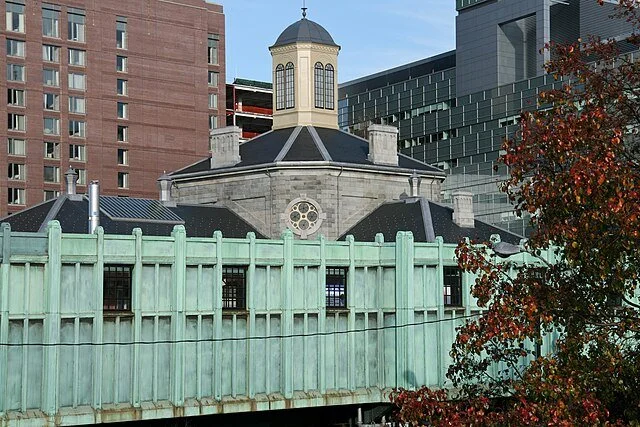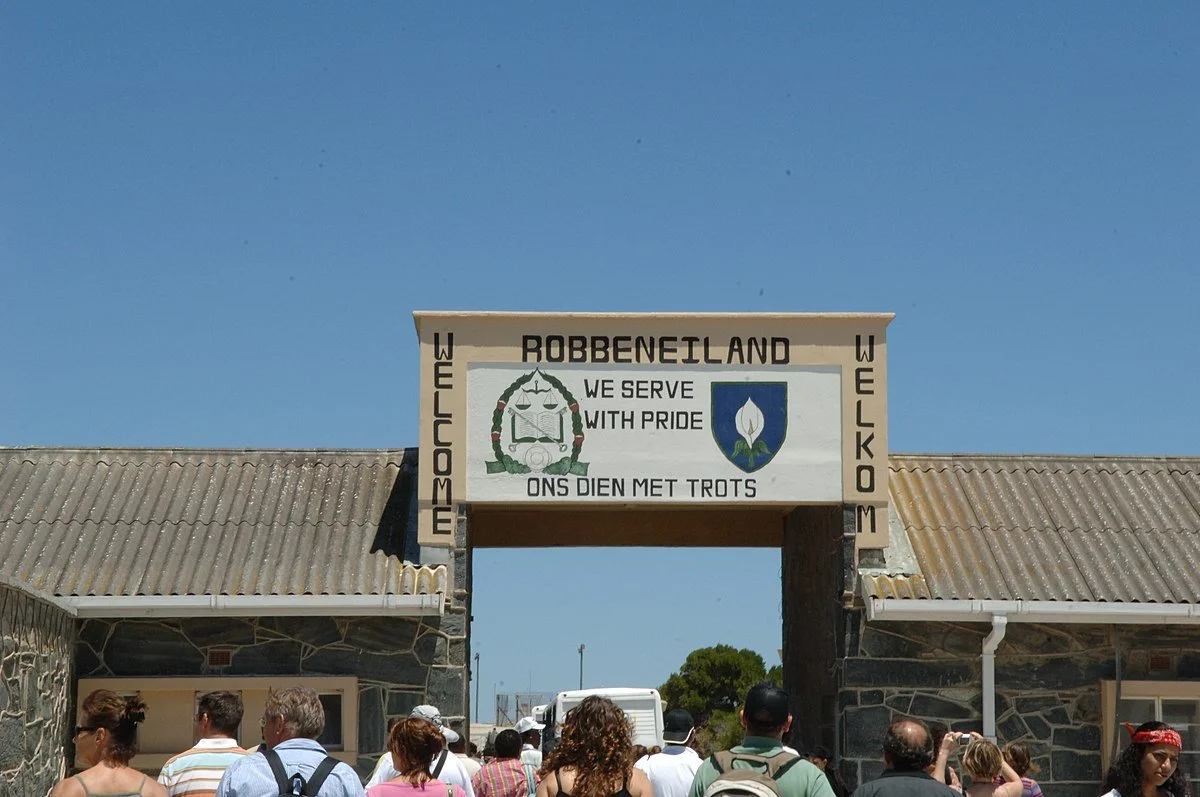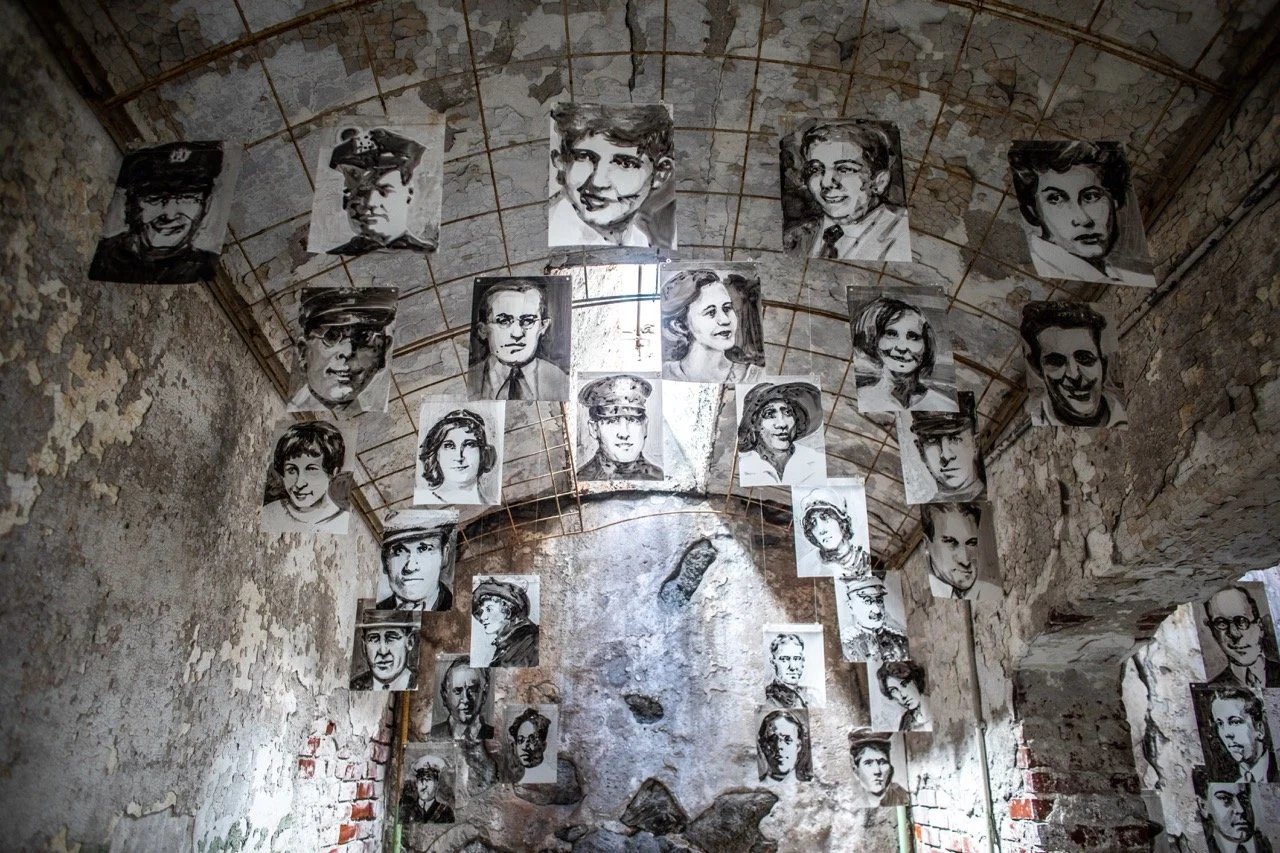Around the world, former prisons have been repurposed into museums and attractions. Is it time to rethink these museums of incarceration?
Former Charles Street Jail and Charles/MGH Station. Tim Sackton. CC BY SA 2.0.
The Liberty Hotel in Beacon Hill, a historic and affluent Boston neighborhood, does not try to hide its history as a former jail. With expensive cocktail bars—cheekily named Clink and Alibi—featuring preserved former holding cells, and a private courtyard in the former jail exercise yard, the luxury hotel features an array of so-called “playful nods” to its past life as The Charles Street Jail.
“With rooms this luxurious,” jests the hotel’s website, “We can’t guarantee that you’ll ever want to leave.” Less advertised are the conditions former inmates, including Malcolm X, faced in the jail, which was deemed unconstitutional in 1973.
Charles Street Jail Complex. Library of Congress. CC0.
The Liberty Hotel, which opened in 2007 following a $150 million renovation, is not a new—or even particularly unique—case. According to a 2022 Sentencing Project report, in the United States alone, 21 states have partially or fully closed at least one correctional facility since 2000, in no small part due to the work of activists opposing mass incarceration. This begs the question of what to do with these facilities—and how to contend with their histories.
Toeing the line between memorialization and commercialization, one controversial answer lies in prison museums, which have become increasingly common destinations worldwide.
Lobby at the Liberty Hotel in Boston. Sharon Mollerus. CC BY 2.0.
Prison Tourism: A Brief Overview
An emerging prison tourism industry, which includes museums, attractions and experiences at former correctional institutions, sits at the crossroads of the informative, the entertaining and the bizarre. Perhaps the most famous example is the former Alcatraz Federal Penitentiary in California, which attracts 1.5 million visitors annually, according to the U.S. National Park Service.
Prison tourism has its roots in penal spectatorship, such as public executions dating back to ancient Rome. And many early modern penitentiaries, including Melbourne Gaol in Australia and Eastern State Penitentiary in Pennsylvania, loomed conspicuously in city centers, visible to all.
Today, scholars characterize prison tourism as a type of “dark tourism”—the practice of visiting former sites of death and disaster. What drives travelers to these sites may be a combination of motivations: to learn, to mourn, or even to indulge a morbid curiosity. While the exact impetus of individual travelers is not always clear, in part due to lack of research and transparency in the industry, clues can be found in the ways prison museums market themselves.
Criminologist Michael Welch notes in his book "Escape to Prison: Penal Tourism and the Pull of Punishment" that prison museums are both educational and commercial institutions, evident in how they pique travelers’ interest and encourage consumption.
On its website, the Clink Prison Museum in London advertises the prison’s “scandalous” history, luring visitors to “hands-on educational experiences” where they can “handle torture devices,” have their photo taken in a torture chair, or even book a “ghost hunt” tour. The Clink is not alone in its jarring blend of education and camp. Prison museum gift shops often feature both educational materials and what Welch describes as “local kitsch.”
Placard featuring The Clink Museum, London. Pikakoko. CC BY-NC-ND 2.0
In Sangareddy, India, the Heritage Jail Museum offers a “Feel the Jail” program, where visitors can pay $5.99 (500 Indian rupees) to spend 24 hours in the former Sangareddy District Center Jail. During their stay, visitors are given prison uniforms and required to do labor such as gardening. The museum doesn’t disclose where money raised through this program goes. In New Delhi, the Tihar Jail is open to visitors every weekday. In 2019, jail authorities told Mail Today that they hoped to establish a similar overnight program at Tihar (though it is unclear if the program was ever instated). One crucial difference: Tihar is currently operating. In fact, with nine central prisons and a population estimated at 14,000, Tihar is one of the largest prison complexes in the world.
Other travel destinations are located on former penal sites, unknownst to most visitors. Koh Tao and Koh Taruto islands in Thailand are known for their idyllic beaches, aquatic wildlife, and off-the-beaten-path feel (the TV show Survivor was filmed on Koh Tarutao in 2002). Yet in the 1940s, both islands were used to detain political prisoners. By one account, 104 prisoners were held in Koh Tao; conditions were incredibly grim, with pervasive malaria and shark-infested waters.
Koh Tarutao Island. Vyacheslav Argenberg. CC BY 4.0
While former correctional institutions handle their histories differently, and while motivations of prison tourists vary, one thing is clear: prison tourism is a widespread phenomenon. Over 100 prison museums in 29 countries can easily be found online. Though the overall impact of the prison tourism industry is unknown—there is no comprehensive data on the industry’s size or revenue—it is clear that demand exists for experiences in former correctional sites and that companies and governments are ready to supply it.
Visitors enter Robben Island. National Archives at College Park - Still Pictures. CC0.
Emerging critiques call the prison tourism industry exploitative and voyeuristic. Critical Resistance, a U.S. group opposing mass incarceration, wrote in 2000 that “marketing of prison imagery, in the form of tourist visits of facilities … helps to promote acceptance of prison expansion.” Others similarly argue that some prison museum attractions minimize the experiences of formerly incarcerated individuals and obscure the current realities of incarceration.
In response, some prisons are rethinking how they market their histories. The Eastern State Penitentiary Museum, for example, recently discontinued its Halloween event “Terror Behind the Walls.” In 2016, it installed an exhibit, “Prisons Today,” which addresses racial disparities in criminal justice. Other prison museums, including Constitutional Hill in Johannesburg, Robben Island in Cape Town and Kilmainham Gaol in Dublin, emphasize the often political nature of punishment and the use of prisons to maintain colonial rule.
In New York City, a new prison museum is in process at Sing Sing, which still houses 1,700 incarcerated people, raising important questions. Is it possible to respectfully navigate these histories while they are ongoing? What does it mean to travel to a prison and, unlike those held there, be free to leave?
Tom Moses, formerly imprisoned at Robben Island, leads a tour on the Island. Martinvl. CC-BY-SA-4.0
Prison Repurposing & Museum Alternatives
Growing movements to reduce incarceration have spurred the closure of more prisons, creating opportunities for prison repurposing. In place of campy and commercial prison attractions, here are some alternatives for travelers hoping to learn about prison histories—and for those hoping to reimagine how former prisons can be repurposed.
For travelers: Do some research on the present state of incarceration in a particular region before attending a prison museum. Is the prison still operating? What has and hasn’t changed since inmates were held there?
Determine who operates the museum and how it is curated. Museums can be informed by political or economic goals. Reflect on how the museum positions you as a visitor; are you invited to empathize with those formerly incarcerated, or is the exhibit more voyeuristic in nature?
If the museum charges fees or sells merchandise, ask where proceeds go. Advocate for increased transparency in the prison tourism industry (similar advocacy has emerged around orphanage tourism, and findings have revealed financial practices that exploit affected communities).
Consider getting involved in work to improve prison conditions for currently incarcerated individuals, reduce incarceration and support public safety through nonpunitive alternatives. Opportunities include supporting community bail funds and reentry programs, advocating against solitary confinement and other harmful practices, and investing in community health.
For those interested in preserving the histories of former prisons: Evaluate how prison museums are marketed, and ensure they do not trivialize formerly incarcerated individuals’ experiences or create a spectacle. When possible, design museums in conjunction with formerly incarcerated individuals and their communities. Make funding and proceeds transparent, and consider diverting proceeds to affected communities.
Follow examples like the “Prisons Today” exhibit at Eastern State Penitentiary and find ways to highlight the current impact of incarceration. Prison museums, as dynamic, living spaces, can offer visitors opportunities to imagine alternatives to mass incarceration.
And consider other ways for prisons to be repurposed that might be more beneficial to communities affected by incarceration. A recent Appeal article asks, “Can Closed Prisons Be Repurposed to Mend the Harm They’ve Done?” The article explores some alternative prison reuse projects, including a former correctional facility in Florida that was converted into a center providing food, housing and support to unhoused individuals.
Eastern State Penitentiary. Thomas Hawk. CC BY-NC 2.0.
A 2022 Sentencing Project report advocates a “community reinvestment approach” to prison repurposing. It offers recommendations for repurposing projects, including prioritizing prison reuse planning, strengthening communities through projects like community centers and healthcare facilities, and increasing data transparency around prison reuse.
The prison tourism industry raises complex questions around how to contend with the painful histories of incarceration, and whether former correctional facilities can (or should) eclipse these histories by taking on new lives and forms. These are difficult questions for travelers. But, at the very least, we can stop perpetuating the harms these sites cause with voyeuristic exploitation. At best, perhaps we can find ways to support affected communities while mobilizing people to think differently about the ongoing harms of incarceration.
Rose Evans
Rose is an independent journalist with a degree in Gender Studies and Creative Writing from Middlebury College. She is passionate about storytelling, women’s and LGBTQ+ issues, criminal (in)justice, and finding creative solutions to collective questions. She also loves sharing good food with loved ones, exploring her home state, and playing soccer in the snow.









